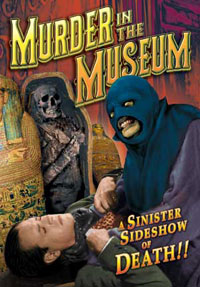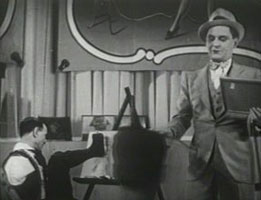 The Murder in the Museum (1934) defines "museum" as a stationary carnival sideshow of circus freaks & magicians. The Murder in the Museum (1934) defines "museum" as a stationary carnival sideshow of circus freaks & magicians.
Such arcades were once encountered in skid row neighborhoods of many major cities, sometimes run year round, sometimes operated seasonally to employ carnies indoors during the winter season when travelling shows had to fold up their tents for a few months.
By summer such "museum" carnies would be on the road again, especially when the enclosed arcades were in climates where pre-air-conditioning temperatures left the buildings massively overheated.
Even the burlesque houses had to close or cook the patrons, & it was typical right up to the 1940s for burlesque theaters to have a "roadshow" that accompanied travellilng carnivals during the summer. The Murder in the Museum accurately reflects this interwoven nature of burlesque shows & carnival arcades.
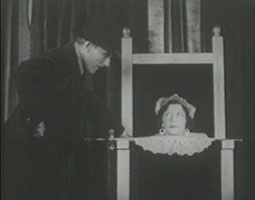 So the film incidentally commemorates a type of business that vanished from the entertainment scene even before travelling sideshows vanished. So the film incidentally commemorates a type of business that vanished from the entertainment scene even before travelling sideshows vanished.
It's too bad the producers couldn't afford a set designer to trick out the Sphere Museum with taxidermed animals including a Fiji Mermaid, & automata inviting further coins from patrons to see them operate, & strange objects generally, as these sideshow museums always displayed a bilzarre collection curios.
We do see a "mustoscope" in the museum, which in such venues generally showed a sexy dancing girl when you deposited your coin & looked through the little window.
The assumptions once held about such businesses is that the participants were all criminal, whether regarded as carnies, gypsies, or museum oddities. This was partly prejudice & more greatly the reality of fringe societies, & the film is not far off the mark linking the carnies' museum to a drug dealer.
The film was made due to the success & notoriety of Tod Browning's Freaks (1932), but unlike Freaks, Murder in the Museum does not so clearly see the humanity of its "exhibits."
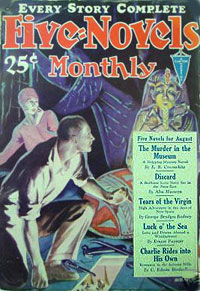 The story is unrelated to Browning's source, but is instead derived from a pulp novella by E. B. Crosswhite in Five-Novels Monthly, August 1929. The story is unrelated to Browning's source, but is instead derived from a pulp novella by E. B. Crosswhite in Five-Novels Monthly, August 1929.
The short story that inspired Freaks was "Spurs" by Tod Robbins, from a rather more upscale magazine, Munsey's, February 1923, & among collectors of supernatural literature, Robbins' short stories have a legendary status.
By contrast, Crosswhite remailns practically unknown even among pulp magazine collectors, & his novella "The Murder in the Museum" forgotten. Sometimes posterity chooses correctly!
Since Browning used some real sideshow performers in his film, Melville Shyer wanted to do likewise, but went about it in the most token manner.
Thus the film features an armless guy who creates paintings with his feet to sell to gawpers for a quarter. Such "armless painters" or "foot artists" were regularly featured in carnivals, & Lon Chaney plays such a character in The Unknown (1927). Unfortunately there is no credit identifying the foot-artist of Murder in the Museum.
That's to it for "real" freaks, the rest being character actors. Symona Bonifice as Katara the Seeress. Symona was the recipient of many a pie in the face working with the Three Stooges. "Elvo the Sheep-headed Cannibal" lives in a box & growls; we don't get to see him, but we do see Bozo who is not a clown but another cannibal act.
So too we have the "Living Head in a Box" simple mirror trick which is a good example of fake sideshow freaks. Other easily tricked out fake freaks that were standards of the trade, but not chosen for this film, were "the four-legged lady," "the lady in the fish bowl," & "the headless lady."
Steve Clemente plays "The Great Darro," a knife-tossing Mexican. Clemente generally played nameless exotic thugs in Z pictures, & frequently made specific use of his very real knife-throwing skills, including in The Sideshow (1928), Tex Takes a Holiday (1932), Mask of Fu Manchu (1932), The Gallant Fool (1933), Fighting Through (1934), It Happened Out West (1937), Under Two Flags (1936), Mad Youth (1940), Sunday Round-up (1936), Sing Your Worries Away (1942), Valley of the Sun (1942), Rookies in Burma (1943), & Murder on the Waterfront (1943). He's featured as himself in the short subject Unusual Occupations (1938) about specialists in the film industry, & he was the witch-king in King Kong (1933).
One realistic sequence is the peepshow with three girls, Fatima, Carmelita, & Little Egypt, these names being typical for carnival shimmy dancers of the era, taking their names from much more famous exotic dancers. Original hoochie-coochie performers for whom the museum girls are named can be seen in the kinetoscope films Fatima (1897), & Little Egypt (1897).
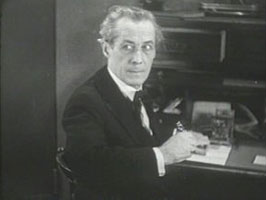 Supposedly, when the film was re-released later in the 1930s as The Five Deadly Sins, new footage was added to extend the "sexploitation" sequence. Some of the additional material can be found recycled in Confessions of a Vice Baron (1943). Supposedly, when the film was re-released later in the 1930s as The Five Deadly Sins, new footage was added to extend the "sexploitation" sequence. Some of the additional material can be found recycled in Confessions of a Vice Baron (1943).
The character actors playing the full array of carnies are somewhat captivating but don't get enough screen time.
Instead we're given a fairly standard who-dunnit. Professor Mysto (Henry B. Walthall) tries to hold his second-rate troupe together while it is being investigated for the murder of a politician (Sam Flint). The would-be reformer was slain while investigating the sideshow's involvement in drug-running.
A reporter (John Harron) falls for the daughter (Phyllis Barrington) of the police commissioner (Joseph W. Girard). The reporter pursues his own investigation into the murder.
Old Dark House type shinannigans progress, with standard poverty row thriller elements including rival gangster shoot-out, heroine threatened, reporter rushing forth to save her from a lusty villain whose old girlfriend (the gypsy fortune teller) gets all femme fatal furious.
The carnies aren't well enough utilized as outside characters dominate the story, but the solution to the crime at least requires a magician's knowledge, & the film is overall busy enough to hold one's attention, but has to be enjoyed for what it is, a relic.
As a very primitive precursor to film noir, The Murder in the Museum has historical consequence merely for being truly cynical.
copyright © by Paghat the Ratgirl
|
